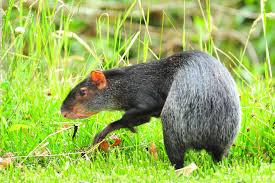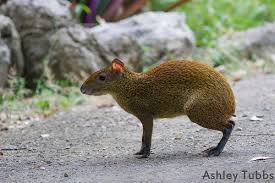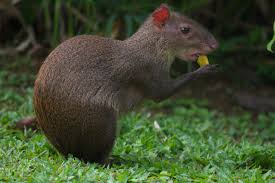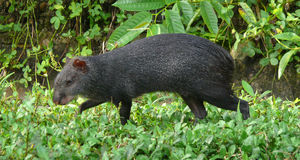
The black agouti is a South American species of agouti from the family Dasyproctidae. It is found in the northwestern Amazon in southern Venezuela, eastern Colombia, eastern Ecuador, western Brazil and northeastern Peru. There is also a disjunct population in the Magdalena River Valley of northern Colombia. The black agouti weighs 3.5-6 kg (7.7-13.2 lb). It is overall black grizzled white, and the throat is white. Like other agoutis, the black agouti is diurnal, lives alone or in pairs, and feeds on fruits and nuts.
They are found in forests, thick brush, savannahs and cultivated areas. In Peru, they are confined to the Amazonian region where they are found in all parts of the low selva zone and many parts of the high selva zone. It is found at altitudes of 2000 m or more. Agoutis live in close proximity to water, being found on the banks of all types of streams.
In some areas, they construct burrows among limestone boulders, along river banks or under the roots of trees.
Conservation status
Least concern
Scientific classification |
|
| Kingdom: | Animalia |
| Phylum: | Chordata |
| Class: | Mammalia |
| Order: | Rodentia |
| Family: | Dasyproctidae |
| Genus: | Dasyprocta |
| Specie: | Dasyprocta fuliginosa |
Description

Head and body length ranges from 415-620 mm. Tail length ranges from 10-35 mm. Fur is coarse and glossy, with the longest and thickest hair located on the posterior part of the back. Fur color ranges from pale orange through several shades of brown to almost black. The underparts are white, yellow or buff colored. The body form is slender, the ears are short, and the hindfoot fas three toes with hooflike claws. Females have four pairs of mammae.
Behavior

Agoutis are basically diurnal, but in areas where they have been affected by humans they may not leave their shelters until dusk. They are terrestrial and are adapted for a cursorial life. They walk, trot or gallop on their digits, and also can jump vertically at least two meters from a standing start. Aggression increases in adults at the onset of every new litter. This is caused by the shortage of available food. During courtship rituals, the male sprays the female with urine causing her to go into a frenzy dance.
Food

Diet consists of fruits, vegetables, and various succulent plants.
Habitat

They are found in forests, thick brush, savannahs and cultivated areas. In Peru, they are confined to the Amazonian region where they are found in all parts of the low selva zone and many parts of the high selva zone. It is found at altitudes of 2000 m or more. Agoutis live in close proximity to water, being found on the banks of all types of streams.
In some areas, they construct burrows among limestone boulders, along river banks or under the roots of trees.
Reproduction
In Venezuela agoutis breed throughout the year. Females have an average estrous cycle of about 34 days, with gestation lasting around 104 to 120 days. They also experience postpartum estrus. Litters are usually made up of one or two young, sometimes three occurs. Newborns are fully furred, have their eyes open and are able to run in their first hour of life. Females lactate for about twenty weeks.Zoológico de Vallarta A. C.
Leave your comments, your opinion is important to us

